Truly, truly, I say to you, unless a grain of wheat falls into the earth and dies, it remains just a grain of wheat; but if it dies, it bears much fruit (John 12:24).
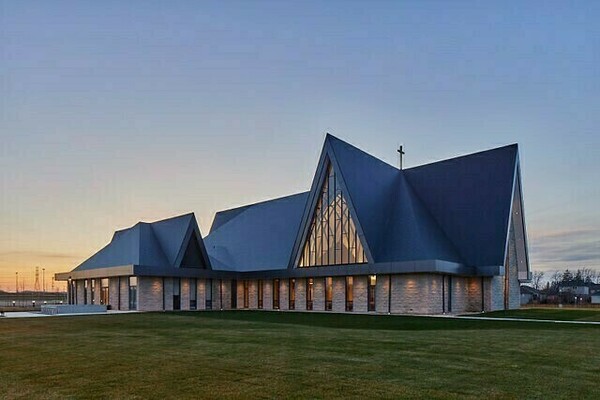
This verse is announced by Jesus just after his entry into Jerusalem for the last time before his passion, death, and resurrection. He is proclaiming the paschal mystery, and in our case, for our new parish, the transformation from the old to the new. We had to plant the grains of wheat from our old two churches, Corpus Christi (CC) and Our Lady of Lourdes (OLOL), and let them die, to then become the new St. Catherine of Siena (SCOS) parish and allow the fruit to blossom and grow.
The story begins with two parish churches, Our Lady of Lourdes (built in 1959) and Corpus Christi (built in 1962), in the Diocese of Hamilton, Ontario, Canada. The city of Hamilton was growing quickly and the Bishop authorized these new parishes to be built on the south part of the city. They were built quickly and in a traditional old style with the altar at one end, and a long, narrow nave for the parishioners to “watch” Mass being said by the priests. Over the years the parishes, as most things do, had highs and lows, growth periods and periods of decay both in the building and in the parishioners who attended.
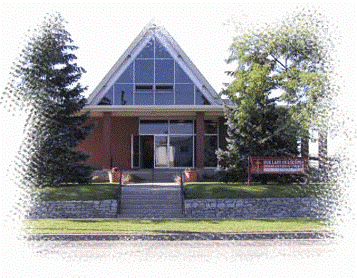
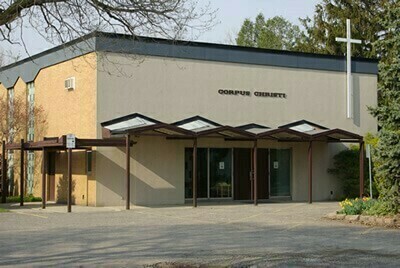
As the twenty-first century began, we realized that the parishes could no longer meet the needs of the people in many ways, and the buildings themselves started to require major renovations and repairs that would cost millions. Regardless of what repairs were done, the issues of inadequate parking, few meeting rooms, no storage, poor audio systems, poor layout for the liturgy, no narthex for gathering, churches open only one hour during weekdays, poor accessibility, office space for staff, etc., could not be fixed with the existing sites.
The churches had served their people well, but the time had come to look at a new solution. Bishop Crosby decided that the best solution would be to amalgamate the two parishes into one new parish. Father Mark Gatto was installed as the pastor to build a new church building, and to close the two previous churches once the new church was dedicated.
The process began with finding an appropriate name for the new parish community, and St. Catherine of Siena was chosen for four key reasons: she was a bridge-builder saint who helped pull together the church in the Middle Ages by bringing the papacy back from Avignon; she is a Doctor of the Church so her writings can be used for the parishes’ spiritual growth; she is a female saint in a diocese that does not have that many churches named for female saints; and she inspired many in her city to personal transformation regardless of their walk in life.
The next key step was in choosing the team that would bring forward the vision for the new church, and in a foreshadowing of parish “synodality,” Father Mark decided not to be the chair of the building committee. I, the parish's permanent deacon (with experience in both business and engineering), was selected to be the building committee chairperson to lead the construction side of this amalgamation.
Father Mark chose to lead the process of bringing the two parishes together from a spiritual and pastoral side. Bringing together two different communities would have its own challenges, including the need to allow the “grains of wheat” of the old parishes and their ways to die, so that new growth could begin. Father Mark and Deacon Tom requested parishioners to nominate themselves or others to become members of the six-person building committee that would lead the process to the new facility. Dozens of great candidates were brought forward, and a strong leadership team was established with three people from each church site, an equal balance of male and female members, skill sets of business owners, engineers, teachers, and a range of ages from twenty to seventy. This diversity really gave a great, highly energized team for the project that challenged each other and our assumptions to get the best result for our parish.
The next step was key for the parish, and that was the creation of a parish “wish list.” We wanted to hear from as many parishioners as possible on what they thought were the key needs for our new building both now and in the future. This was a great asset, as the people know what makes a great church facility, having been around the world and seen the good, the bad, and the ugly as far as churches go. In addition to this, we visited the previous three churches built in our diocese with the key questions: “What would you do differently? What did you miss?” Each of these parishes spoke of a shortage of meeting rooms or storage. It was very interesting to us to merge the feedback of both streams of information to drive the future design. The Top Ten things that came out were:
1. “It should look like a Catholic Church,” which meant that a leaning toward some traditional features was important. It should be a church that “pulls you in” and makes you feel welcome.
2. “The acoustics should be excellent in all areas for all people,” which told us that the sound system would be critical.
3. “Ensure it is child-friendly in all aspects of design, so families feel welcome.”
4. “Parking, parking, parking,” as both previous locations had no parking and the people had to park on side streets for many years.
5. “The music ministry should be flexible for all styles and demographics,” which told us that we had to accommodate from organ to digital piano to any other music that would help us have “full and active participation.”
6. “It should be easy to access for people of all capabilities,” which drove the design for zero stairs, no basement, seating locations, and places for walkers, etc.
7. “Modern audio and visual systems for all meeting rooms and areas,” so that all teaching, RCIA, St. Vincent de Paul Society, Knights of Columbus, etc. work can have the latest technology available to them.
8. “Gathering spaces” for people, so that after Masses people can share their lives with each other.
9. “Can the church be open all day?” Is it possible to have a way to keep the church open for reflection and prayer?
10. “Can we have a kitchen/hall that will allow for community events and possibly help others in need?”
The key challenge that Father Mark asked the committee to focus on was a spirit of “welcome” that would be embedded in everything we do at the new site in the spirit of “come to me, all you who are wearied and burdened, and I will give you rest” (Matt 11:28).
With this vision in mind, it was now time to bring in two key skill sets: a liturgical designer and an architect. A liturgical designer, Klaas Design, was brought in to ensure that the design met the needs of liturgy as well as a welcoming Catholic design. The architect, ATA Architects, brought the skill set of the facility design to meet the ten key points above, while merging this with the liturgical design. In all honesty, this combination created a lot of vocal dialogue and debate, but all of it with passion and focus on the joint goal. The design phase took approximately one year to get the right balance of all targets and to meet a reasonable budget. (It should be noted that the sale of the two current properties was estimated to make up approximately 50% of the final construction price.)
The construction phase began after a two-year municipal permitting and approval process. A key goal was to use as many local resources as possible (similar to the building of Catholic churches in history with the whole local community involved.) Ninety percent of the work was locally sourced, and this led to a key advantage—attention to detail and great quality. The local companies and workers took a very personal interest in the project, feeling the weight of the legacy that they would leave to their own children, grandchildren, and great-grandchildren. The vision to see themselves walking through the church hand in hand with their families drove a passion for excellence which is seen in all aspects of the facility.
In parallel, just as important as the building, the focus was also on building up the community of faith, bringing two communities into one. A synod body of twenty parishioners was established with members of both previous parishes. This group discerned the needs of the new parish from a spiritual viewpoint, including youth ministry, adult education, RCIA and Alpha programs, coffee Sundays, etc., as well as how to reach out for volunteers to run all the desired programs. One key point was that at both previous sites, the desires were there for these ministries, but the facilities and/or the volunteer capacity did not allow for the programs to be run. A pent-up demand for community activity in the parish had built up, and the new site would allow us to take advantage of this. As part of this, we implemented a new online volunteer registration and scheduling system to facilitate volunteers and make the parish “easy to work with,” so there were no barriers to stewardship. In addition to this work, there were also trips that allowed parishioners from both sites to meet each other and one schedule for weekday masses that switched locations between the sites while we were building, which again let people meet each other.
It should be noted that we had to allow a natural process for the “grains of wheat” to die, and new life to grow. There was a lot of emotion and sentimentality for people who had seen their lives and their families’ lives grow in the original locations, and this was not downplayed. As we neared the entry into the new church, we had memorial masses for each parish to celebrate and honor the past in a spirit of gratitude. Allowing people to grieve the loss of the old sites, regardless of how bad the physical state of the sites was with leaking roofs and basements, was a crucial step to be able to fertilize the seeds of new growth.
In addition to this, we did not abandon everything at the old locations, but we took the best of what was there and brought it into the new facility. We built an adoration chapel called the Corpus Christi chapel and included the Stations of the Cross and two statues of Mary and Joseph from that site, as well as bringing the processional cross to the new church. We included an outdoor grotto for Our Lady of Lourdes, with a new bronze statue of Our Lady. We also brought over the tabernacle as well as the stations of the cross and put them in the new nave. One surprise for us was that the stations of the cross at OLOL were not really appreciated before as they were high up, with poor lighting and dark colors. They seemed old and not worth saving. Once we took them down, we realized we had 100-year-old handmade mosaics from Italy, so they were refurbished, brightened, and in the new church lowered to eye level so they could be seen and touched. They bring real joy to the space.
The design of the new church is, for lack of a better term, Modern Gothic. It incorporates Gothic windows and tracery as well as curved Gothic ceilings to simulate the feel of a European Gothic cathedral. This was done utilizing modern construction technology like high-strength structural steel tubes and I-beams, as well as thin, reinforced concrete curved panels for the ceiling, that was put together like a giant hanging jigsaw puzzle. It was amazing to watch, and you can see the construction time-lapse on YouTube. The church also features lots of natural light, very clean sight lines with a natural focus on the altar, and reredos where the sacrifice of the Eucharist takes place.


The church is wide and short so that every one of the 700 seats feels close to the celebration and the acoustics, the music, and the sight lines pull you toward the altar. There are also two shrines at the back of the church that were commissioned for the space featuring the Holy Family and St. Catherine of Siena. One of the great joys is the constant mention by people who come to the church of a feeling of peace and calm, which is truly what people are craving in this hectic, modern world that we live in.
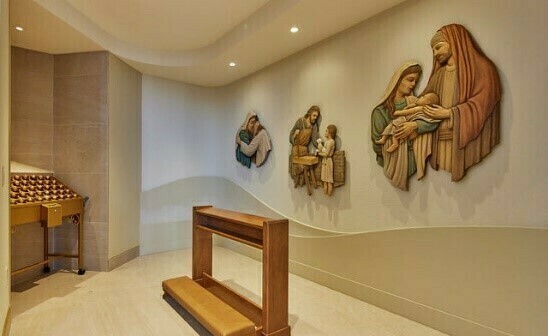

One other key feature that has really brought joy and community to our new parish is the narthex, which is 1,000 square feet and has a welcome/reception area as well as direct access to our church hall. Within weeks, we had people stay after mass to chat with fellow parishioners for up to forty-five minutes. It is also a great space before and after funerals, weddings, baptisms, etc., allowing families to reconnect and spend time together. In both previous sites, this did not exist, and people instead headed directly to their cars, especially in any inclement weather (and the cold Canadian winters!). People feel welcome and there is no pressure to leave, but instead an invitation to “stay and rest awhile” (Mark 6:31).
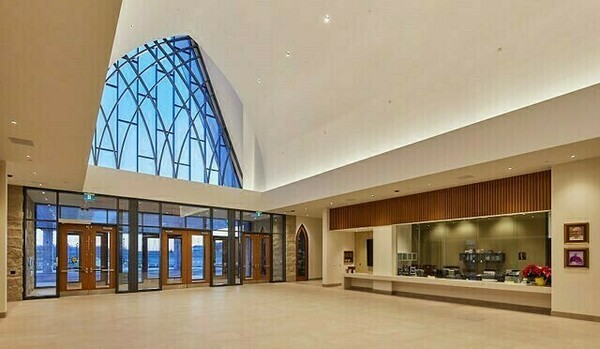
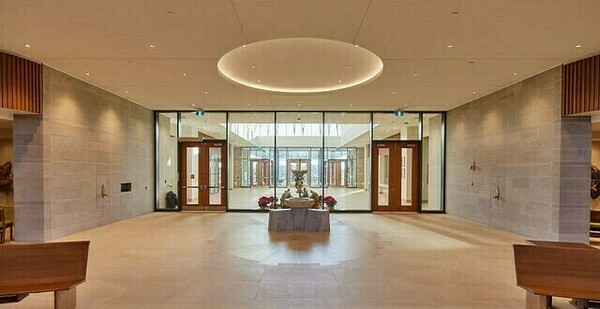
Our dedication Mass was on October 22, 2023, and it was a fantastic celebration presided over by Bishop Douglas Crosby. It was an incredible day with over 1,500 people attending in every part of the facility, with the Mass live-streamed into our parish hall for the overflow. As a part of this celebration, we invited representatives from all Christian churches and faith communities in our parish boundaries to join us. They were delighted to be invited and we had over a dozen multi-faith ambassadors for the opening. From that day on, in the new church, it became clear that something new had arisen, and we could see that, “As for what was sown on good soil, this is he who hears the word and understands it; he indeed bears fruit, and yields, in one case a hundredfold, in another sixty, and in another thirty” (Matt 13:23). Weekend Masses have been full ever since the opening and we have had over 500 new family registrations. Children’s liturgy is offered at all Masses and the burst of families, the cry of newborns, and the joy of children is seen every weekend.
The bearing of fruit is shown in so many ways: a newly vibrant Catholic Women’s league, a doubling of our volunteers for St. Vincent de Paul outreach, Christian meditation groups, Fun & Friendship groups for those over 55, a new youth group, a children’s choir, RCIA, and Alpha groups. In the past nine months since opening, we have had over 100 children baptized, first communions and confirmations! Our weddings have doubled, and we now have wedding preparation weekend with our own parish couples at our new church, which allows for more community to be built up amongst our young people. We have increased our outreach to the poor in the community with our “Hearts to Hands” group that makes blankets for the homeless, and we are starting a ministry to make 400 meals once a month to support the DeMazenod Door Outreach in our city center.
It has been an incredible journey these past six years, and the grain of wheat that died with two old churches has burst forth out of the ground and formed something new and unexpected. With over 300 volunteers, a spirit of synodality in which all bring their gifts to the service of the people of God, and a humble parish team that allows all to grow in their faith, we hope to continue this journey of God’s love in the Hamilton community. We thank all of the people for their patience, their generosity and their willingness to support us on this journey of faith. It is truly a resurrection story that allows us to see the paschal mystery and know that “unless a grain of wheat falls into the earth and dies, it remains just a grain of wheat; but if it dies, it bears much fruit” (John 12:24).

